I have been surfing my entire life and spent many years skateboarding on the streets and in skateparks during my childhood. It wasn’t until I rode a surfskate in California many years ago that I fully began to understand the connection between surfing and skateboarding. After a few pushes down the boardwalk at Pacific Beach, I couldn’t believe that I was generating speed by carving from heel to toe, a movement that closely replicates the motion of surfing. I was immediately hooked and looking back I can see the role that surfskating has played in my progression as a surfer.
As surfskate grows in popularity around the world and more surfers, snowboarders and skateboarders get into the sport, I often get asked ‘How do I choose the right surfskate?’ With a plethora of options available on the market, making a decision can be overwhelming to say the least. To help you narrow down your options, we are going to break down every aspect to consider when choosing your first surfskate.
For starters, there are many brands available in the market. If you want the best surfskate available, look no further as Carver is your brand of choice. A trailblazer in the industry, Carver Skateboards was founded in 1996 by Neil Carver and Greg Falk in Venice, CA with the goal to bring the feeling of surfing waves to the streets on flat days. Over the past 25 years, the company has focussed all its energy into refining and evolving their technologies to create the best performing surfskates available. Despite their exponential growth, all their boards are still hand-built to precise specifications at their headquarters in El Segundo, a few miles south of Venice’s boardwalk.
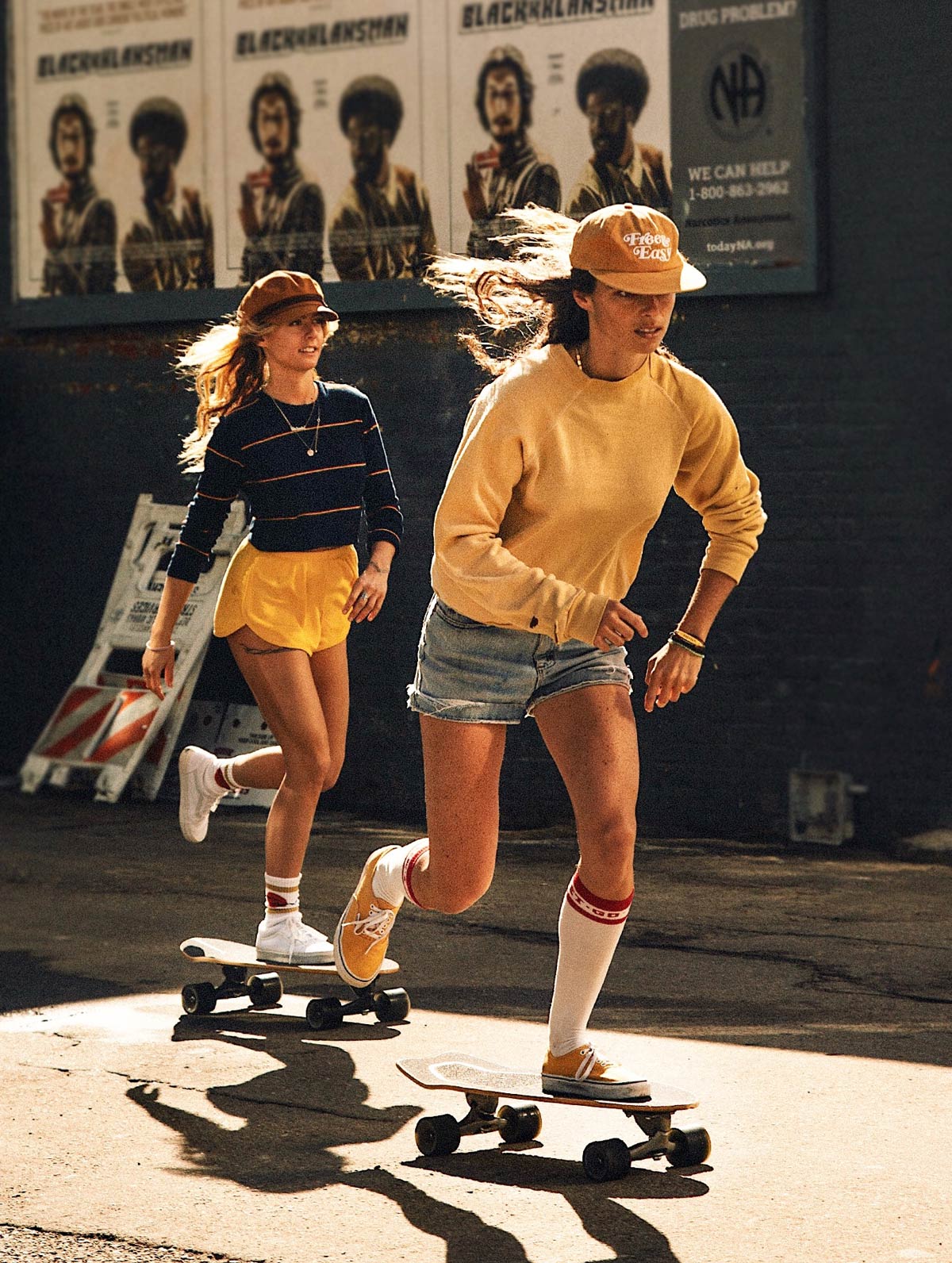
Initial Considerations
The best starting point in choosing the right Carver is looking at your own measurements. Your height and weight play a significant role in determining the board that is best suitable for you. Your skill level and experience in surfing, skateboarding and snowboarding can also come into play. It should be remembered that while informative, no prior board sport experience is required to reap the benefits of owning a surfskate. For those with a little experience, your riding style will help you narrow down the choices. Do you prefer cruising down the mountain making wide turns or do you spend most of your time in the park hitting rails and boxes? Do you ride a cruisy single fin mid length surfboard or is a fast potato chip with a thruster set up your usual board of choice? Do you spend your time cruising along the boardwalk on a longboard or do you prefer to spend your days in the bowl or doing tricks in the skatepark?
If you are completely new to any boardsport, the decision becomes a lot easier as you will be looking for stability and ease of ride. Regardless where you are with your skills, it's important to ask yourself where you would like to see yourself in a year or two after getting your first Carver. We all have goals in life and perhaps having a goal to work towards will make it easier to narrow down your options. Do I see myself shredding the walls of my local skatepark? Do I see myself practicing specific advanced drills to take my surfing to the next level? Or, do I see myself carving my life away on the boardwalk or city streets to get around the city? If the answer is all of the above, it may be best to focus on the most achievable one to start.
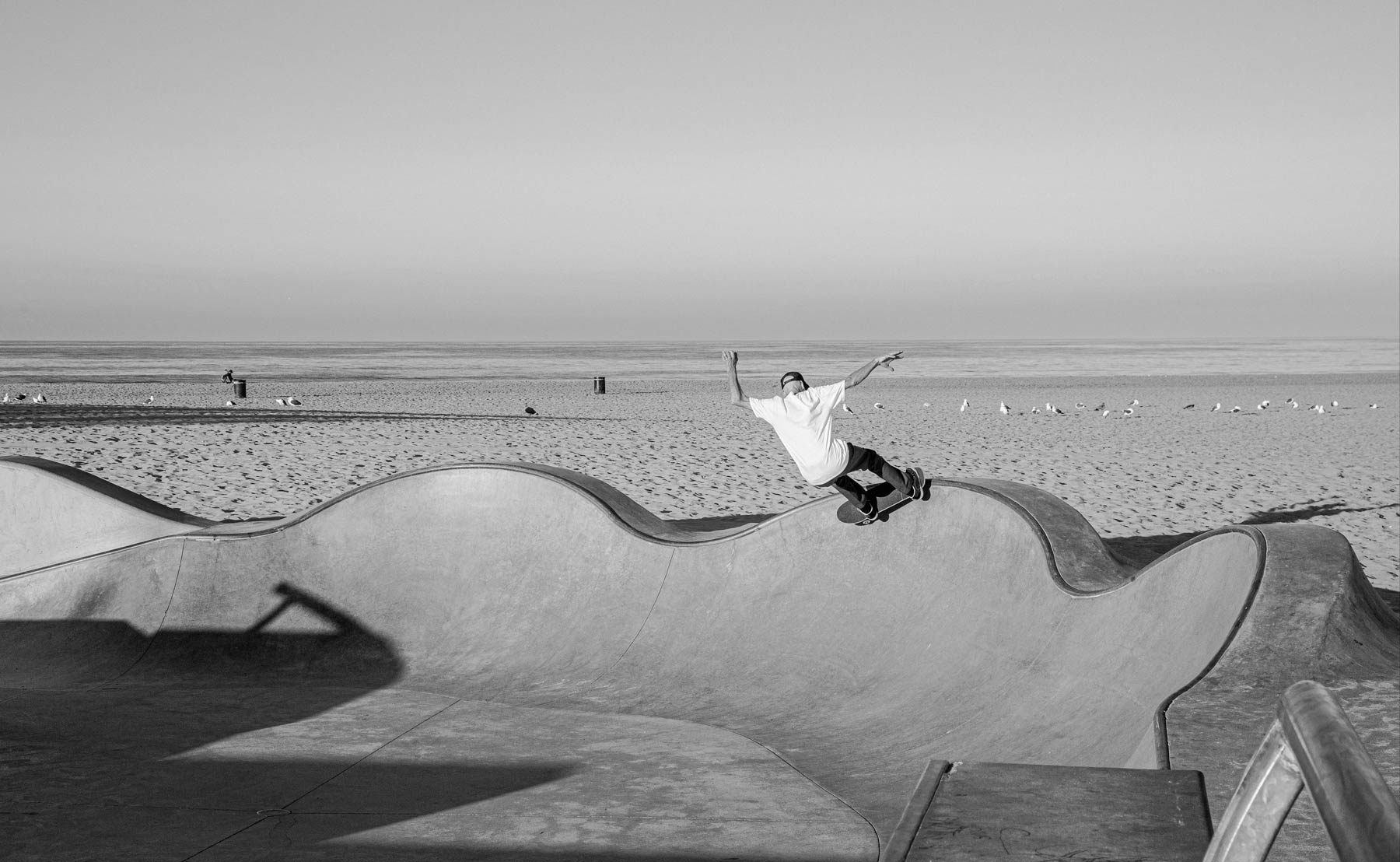
The Anatomy of a Carver
Before you can choose which board is the best choice for you, it’s important to have a good understanding of what makes a specific board ride a certain way. So let’s begin to break it down.
Carver makes three main distinctive truck systems: C7, CX.4 and C5. If you are looking for a Carver to cruise, carve, and practice sharp turns in and out of the park you will be looking at the C7 or CX.4. If you are coming from a street skateboarding background and want to add the carving motion to your skateboard, you would be looking at the C5. Let’s dig deeper into the differences in design, construction and performance as described by Carver itself.
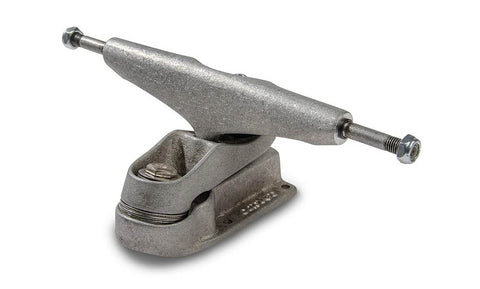
C7 Truck
This is the signature truck that started it all. The C7 remains the smoothest turning, fastest pumping surf truck ever made, being at the leading edge of true surfskate performance. The patented second axis of this front truck not only increases the turning radius of your carve, but lets you snap the nose and pivot your turns off the tail. This dynamic relationship between the trucks creates thrust and drives you forward with increasing speed. The striking similarity to surfing performance has made the C7 the choice for surf training by pros and amateurs alike.
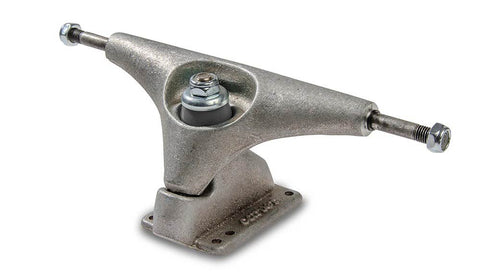
CX.4 Truck
This is Carver’s hybrid surf and skate truck. It’s a lightweight standard Reverse King Pin (RKP) hanger and base, and it has a patented geometry that squeezes every bit of turn and pump from the system. This means that you can pump this truck like a C7, but it lands airs and rides fakie with more stability. This truck system opens up aerial maneuvers, and keys in with the latest progression of airs in surfing.
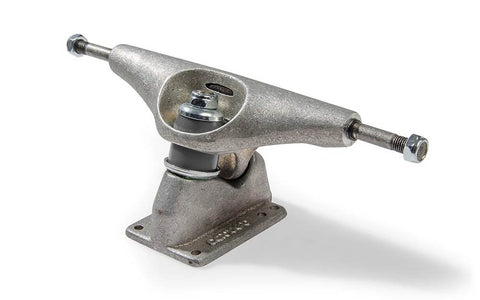
C2.4 Single Rear Truck
This classic configuration of skateboard truck is the rear pivot for both the C7 and CX sets. It's been tweaked to work in tandem with the extreme turning characteristics of the front trucks. The steeper kingpin increases the rail range, and the taller baseplate is the perfect match for the taller front trucks, creating a synchronized system that also helps prevent wheel bite.

C5 Truck Set (Street Skate)
For years Carver has been blending surf and skate, but as surfskate progresses and riders incorporate more traditional skateboard tricks into their style, Carver set out to design equipment that supports this progression. Skateboarders have invented many great tricks since the early days, and a truly modern surfskate needs to incorporate this history of progression. Lower, narrower trucks, new school double kick deck mold and smaller wheels all facilitate tricks while still supporting grippy, snappy carving. And so the C5 System (C5 front, C4 rear) is shorter and narrower, lowering the center of gravity and giving the tail more pop. You get higher ollies, and better control. And the narrower hanger and deck keep it light and maneuverable. This is the next generation of surfskate, blending tricks and flow into a complex, creative expression across the urban landscape.
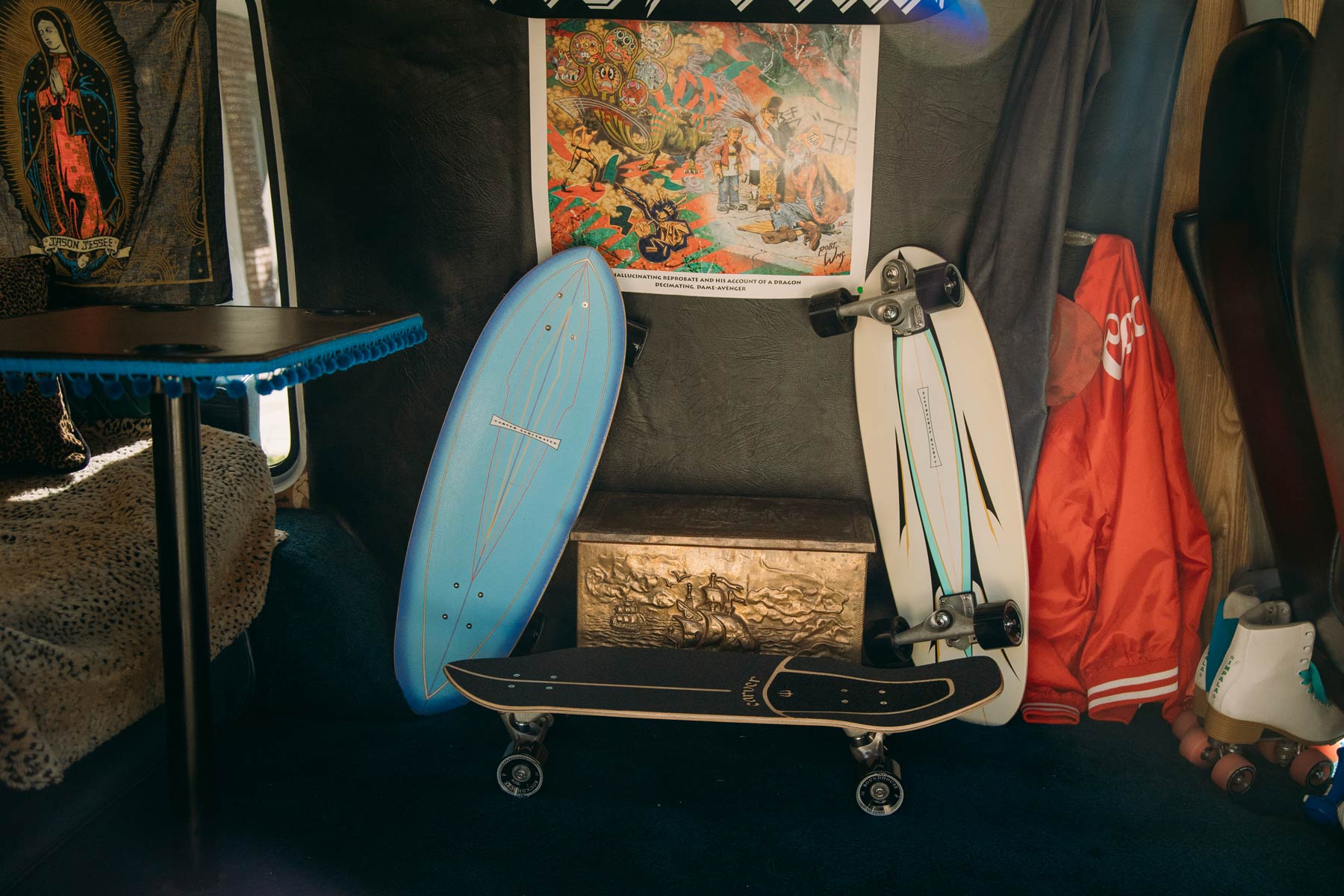
Decks
The deck of a surfskate is the wooden platform on which the trucks are mounted. The front of the deck is referred to as the nose and the rear as the tail, just like in surfboards. The tail—and sometimes the nose—are concave and raised to create a functional kicktail for maneuvers. Each deck is designed following aesthetics and functional considerations in terms of the overall outline, width, length, kicktails, as well as concaves. Depending on your style of riding, these design features may come into play when choosing your Carver. However, if this is your first board, you don’t need to get too hung up on this.
The top of a skateboard deck is covered by a sandpaper-like sheet called griptape, giving you traction and control of your skateboard the same way your traction pad and wax create traction on a surfboard. There are eight small mounting holes in a deck—four near the tail and four near the nose—drilled to allow the attachment of the trucks to the board. A very important measurement is the wheelbase—which is the distance between the inside mounting holes on a board. This measurement should be approximate to your stance as you want your feet position on top of the trucks as you carve.
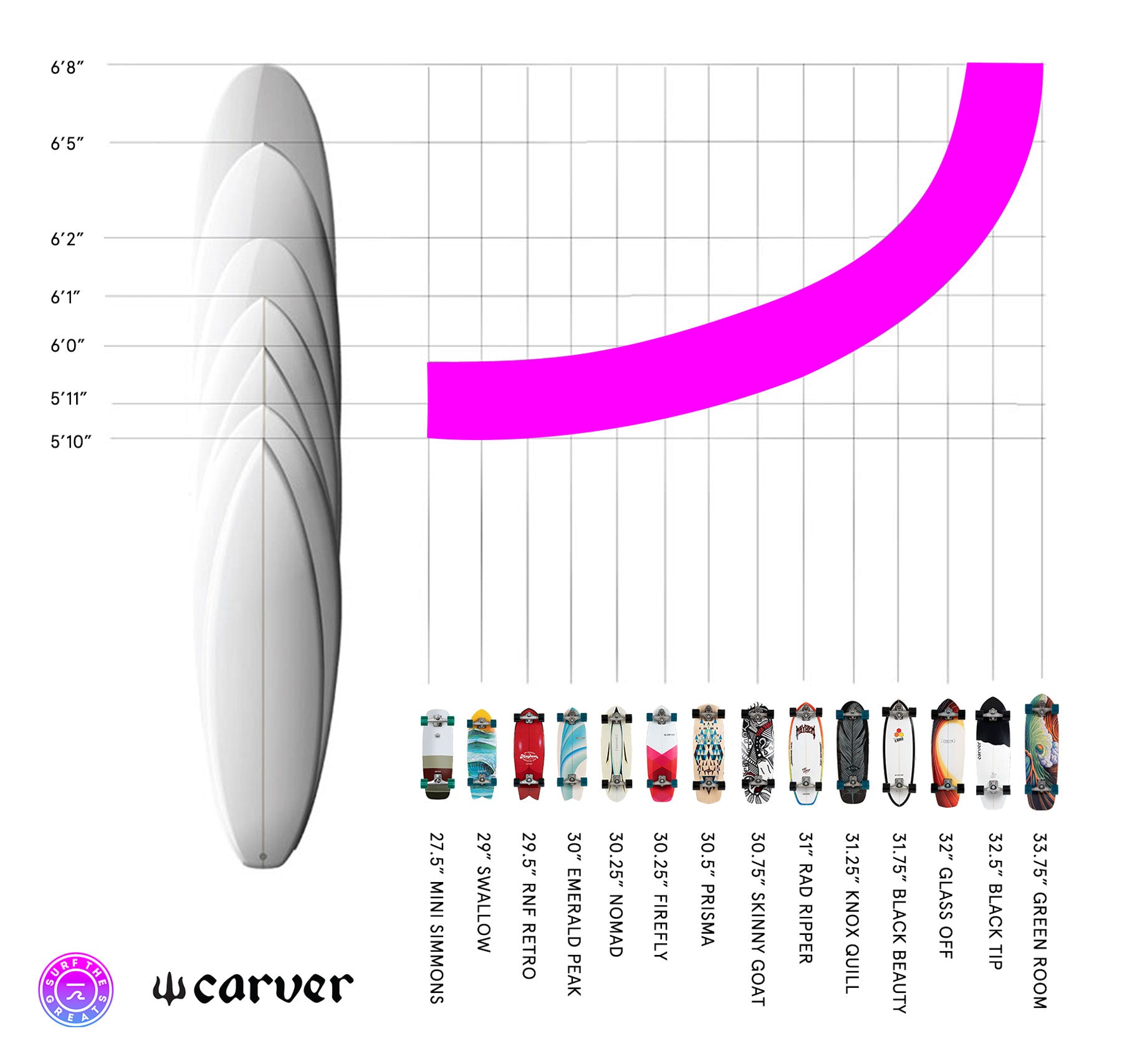
When it comes to choosing the right Carver for you, the one aspect to know is that the smaller the board the tighter turns it will make it—similarly to a surfboard. On the other hand, the longer the board the more stable it will be. If you are a shortboarder looking to practice sharp turns, cutbacks, snaps and slides, you will be looking at some of the shorter boards. If you are a beginner or intermediate rider looking for stability to cruise around town and practice carving and progressing into more advanced maneuvers, a longer board may be a better option for you. Always keeping in mind that your wheelbase should be proportional to your surfskate stance—more on that later.
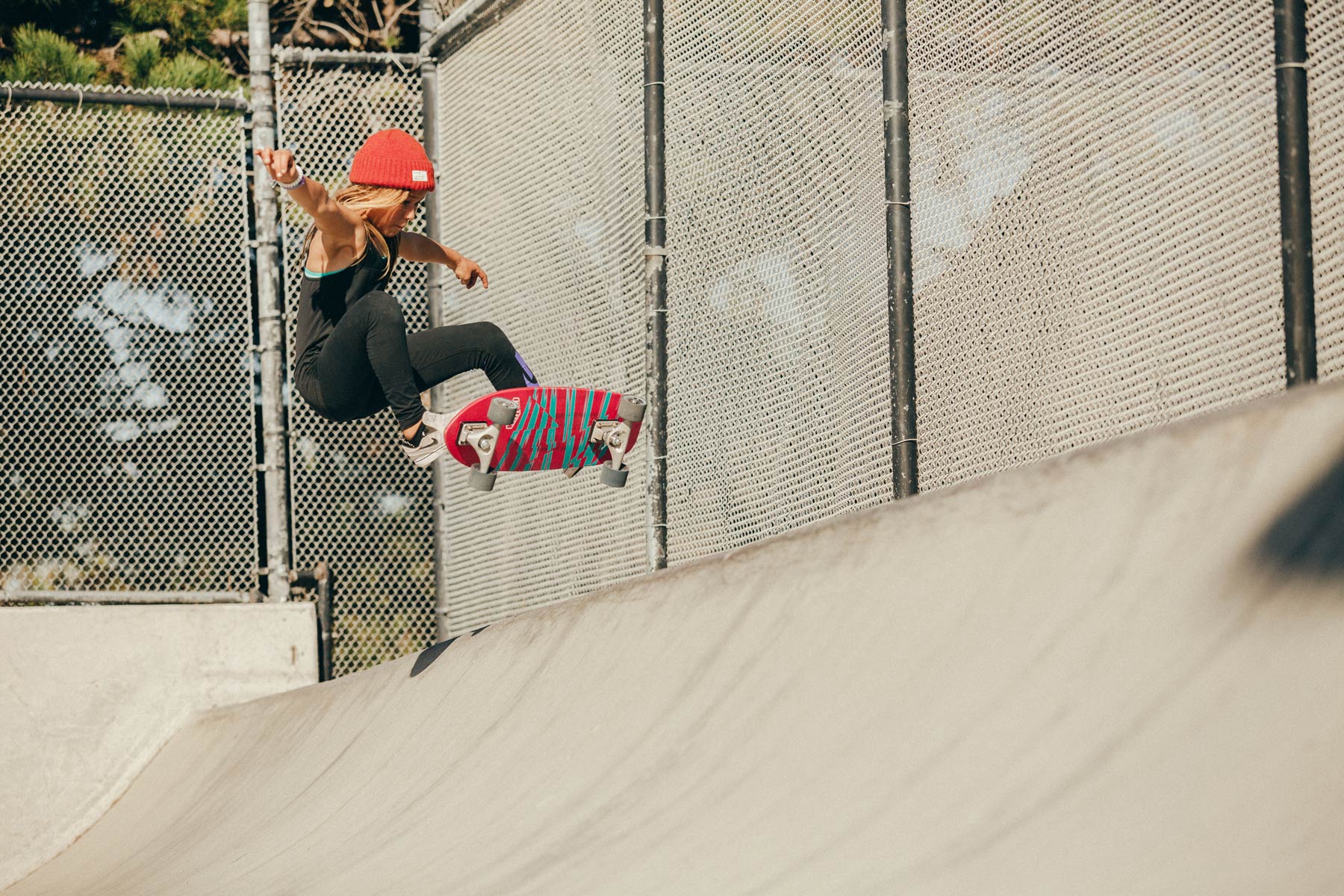
Wheels
There are several types of skateboarding wheels available on the market varying in composition, diameter, width, density, and with different concave profiles and edge contours. Carver has put decades into research and production of its in-house wheel brand Roundhouse—all designed and manufactured in the USA. Smaller wheels are better for tricks, riding in the bowl and speed control. Larger wheels can run over cracks and debris, and offer more speed for carving and longer rides. Carver uses the Durometer A Scale—a 100-point scale that quantifies how hard a wheel is. The higher the number, the harder the wheel—faster rolling and better for smoother surfaces and slides. The softer the wheel, the gripier it is, being better suited for riding around town. For added grip and to enhance the carving motion, some Roundhouse wheels are designed with a concave.
If all this wheel talk seems overwhelming to you, do not worry as Carver assembles each board with their suggested wheel set. Regardless, we are going to break down the different types of wheels available so as you get better or your wheels begin to wear down, you can choose a set to perform according to your needs.
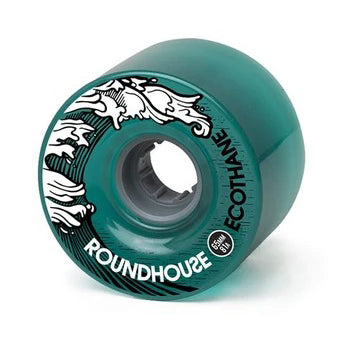
Roundhouse Ecothane Mag Wheel Set 65mm 81A
Grippy and fast rolling just like the 70MM Mag, but lighter and more compact. Hardened to an 81A to keep a fast roll with the smaller diameter. The harder 81a durometer speeds things up, making this the ideal surfskate wheel for the park and for slides.

Roundhouse by Carver ECO Concave Wheel Set - 69mm 81A
The Concave profile is already one of the grippiest wheels we’ve ever ridden, and now it’s even grippier. And the harder 81a durometer speeds things up, making this the most perfect surfskate wheel we’ve ever ridden.

Roundhouse Ecothane Mag Wheel Set 70mm 81A
A grippy, yet fast rolling wheel with a thin outer lip and solid corprofile creates the perfect balance of easy pushing and sticky carving, faster and stickier in the 81a Ecothane.
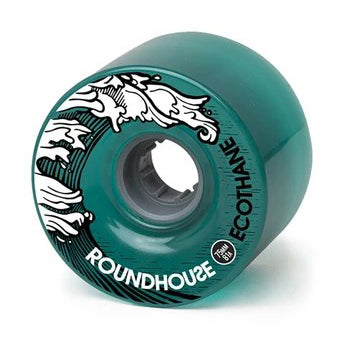
Roundhouse Ecothane Mag Wheel Set 75mm 81A
A grippy, yet fast rolling wheel with a thin outer lip and solid corprofile creates the perfect balance of easy pushing and sticky carving, faster and stickier in the 81a Ecothane.
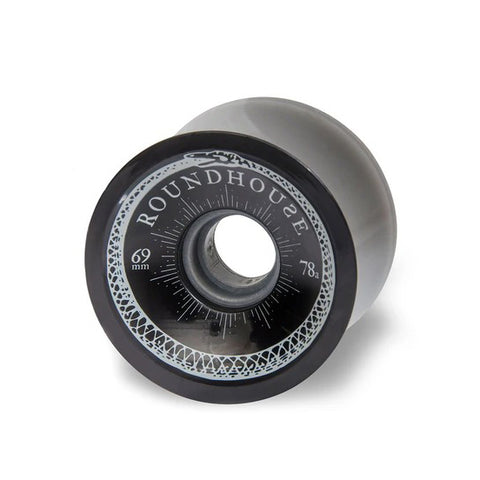
Roundhouse Concave Wheel Set 69mm 78A
The need for grip has never been more important than in surfskate, where you rely on the traction of the wheels to fully lean into carves and cutbacks. Roundhouse Concave Wheels give you extra projection out of your turns so you can complete maneuvers you’d otherwise slide out on. The key to this design is the concave riding surface which—when under weight—produces an hourglass-shaped contact patch. This increases the surface area and pushes the lip into the ground, creating more grip than ever before while maintaining consistent roll speed. These are the grippiest wheels you’ll ever ride.
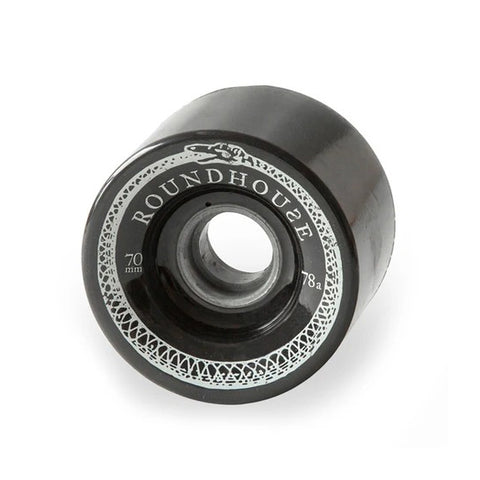
Roundhouse Mag Wheel Set 70mm 78a
This wheel is all about grip and speed. The Mag is a delicate balance of a square-edged lip to maximize grip and a harder center profIle for speed. The key is in the shape of the lip; thin at the edge but quickly getting thicker, with a hollow relief near the core. What this does is create a spring-loaded, rebounding lip, so each time you pump for speed the wheel pumps back. And because the contact patch is nice and wide you can really dig into your rail and these wheels stick.

Roundhouse Park Wheel Set 58mm 90a
The surface of a skatepark is so much smoother than the street, so you don’t need as big or soft of a wheel to roll over the cracks, but you still want good grip and a fast roll. Typical park wheels are very hard and feature rounded edges that slide out easily, so the Roundhouse Park wheel is a bit wider and softer than your typical park wheel. The 90A durometer rolls much faster than softer urethane on the smooth concrete, and the thinner lip profile gives the lip a little bit of flex, which further increases grip.
The small rounded edge on the lip preserves the side shape for smith grinds and other coping tricks where the wheel needs to slide without hanging up. It’s harder and smaller than Carver’s standard road wheels so you roll faster on the smooth skatepark surface, and the lower height adds stability and control while adding pop to your ollies. All these ingredients come together to give you a very versatile wheel that combines traditional park properties with Carver’s special surfskate demands to transform your set-up into the ideal skatepark surfer.
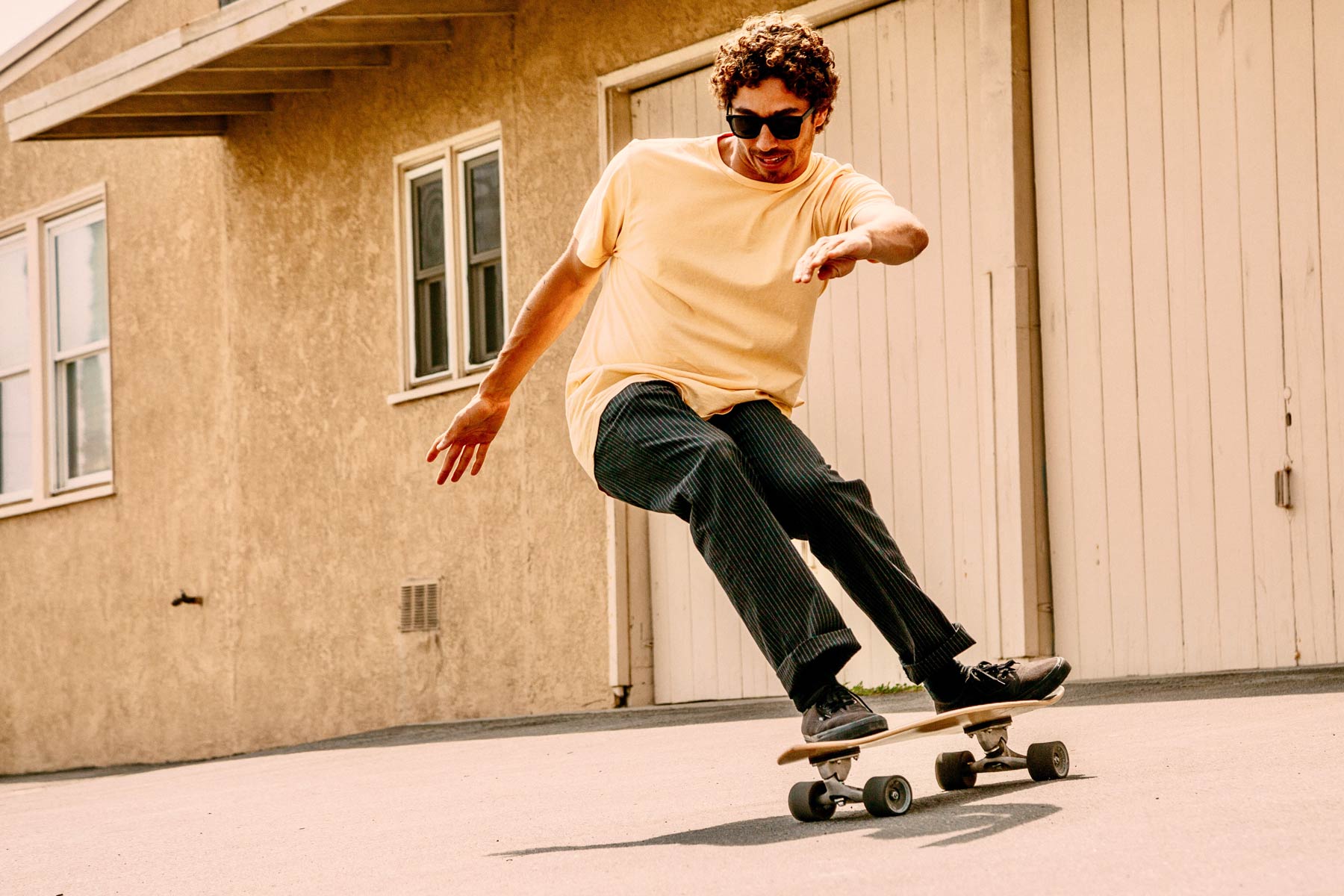
Defining your surfskate stance
With all this in mind, the most important aspect of choosing the right Carver is your surfskate stance width. So go ahead and get up, stand upright with your feet aligned with your shoulders, positioning both arms forward, as you gaze forward. Imagine you are surfing or carving and move your body forward and back a bit. Does your stance feel too narrow? Widen the feet by an inch or two. Does it feel too wide? Narrow your feet by an inch or two. Repeat until this stance feels natural to you.
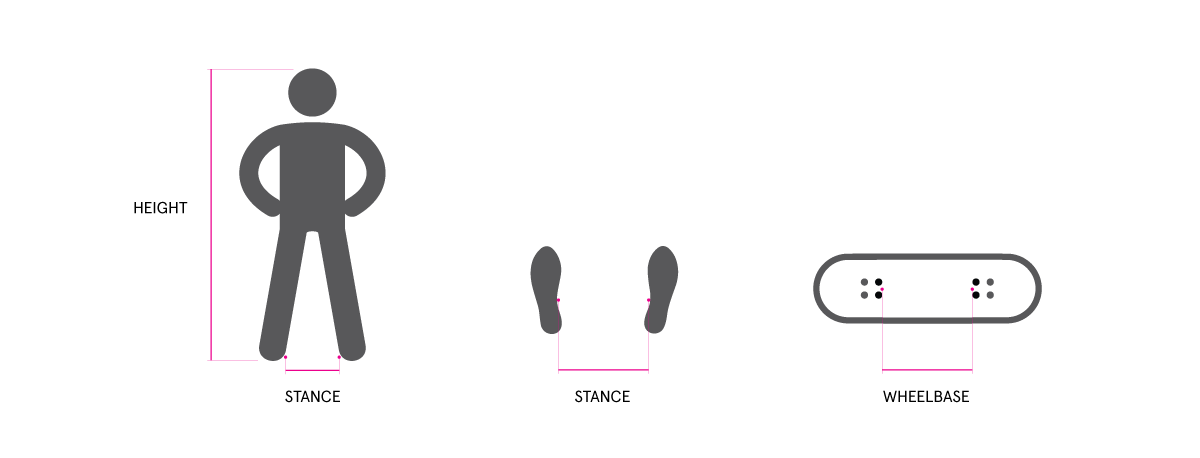
Using a ruler or a measuring tape, measure the distance between the centre of your inner left foot and the centre of your inner right foot. Subtract 1” from this number and this will give you the lower number of your range. Now add 1” to your original measurement, giving you the higher end of your a range. For example, my measurement is 16” giving me a range from 15” and 17”. This is a reasonable range for your surfskate stance, and you can look for Carvers with wheelbase distances in this range. To make your life easier, we put together a table with suggested wheelbase ranges based on your height. It’s important to highlight that these are just approximations and rough guidelines and each rider's surfskate stance varies slightly. However, this should give you an idea of which wheelbase distance would work for you.
Height |
Wheelbase |
| 4’0”–4’6” | 14”–15” |
| 4’6”–5’0” | 14”–15.5” |
| 5’0”–5’6” | 14”–16.5” |
| 5’6”–5’9” | 15”–17” |
| 5’9”–6’0” | 16”–17.5” |
| 6’0”–6’3” | 17”–19” |
| 6’3”–6’6” | 17”–20” |
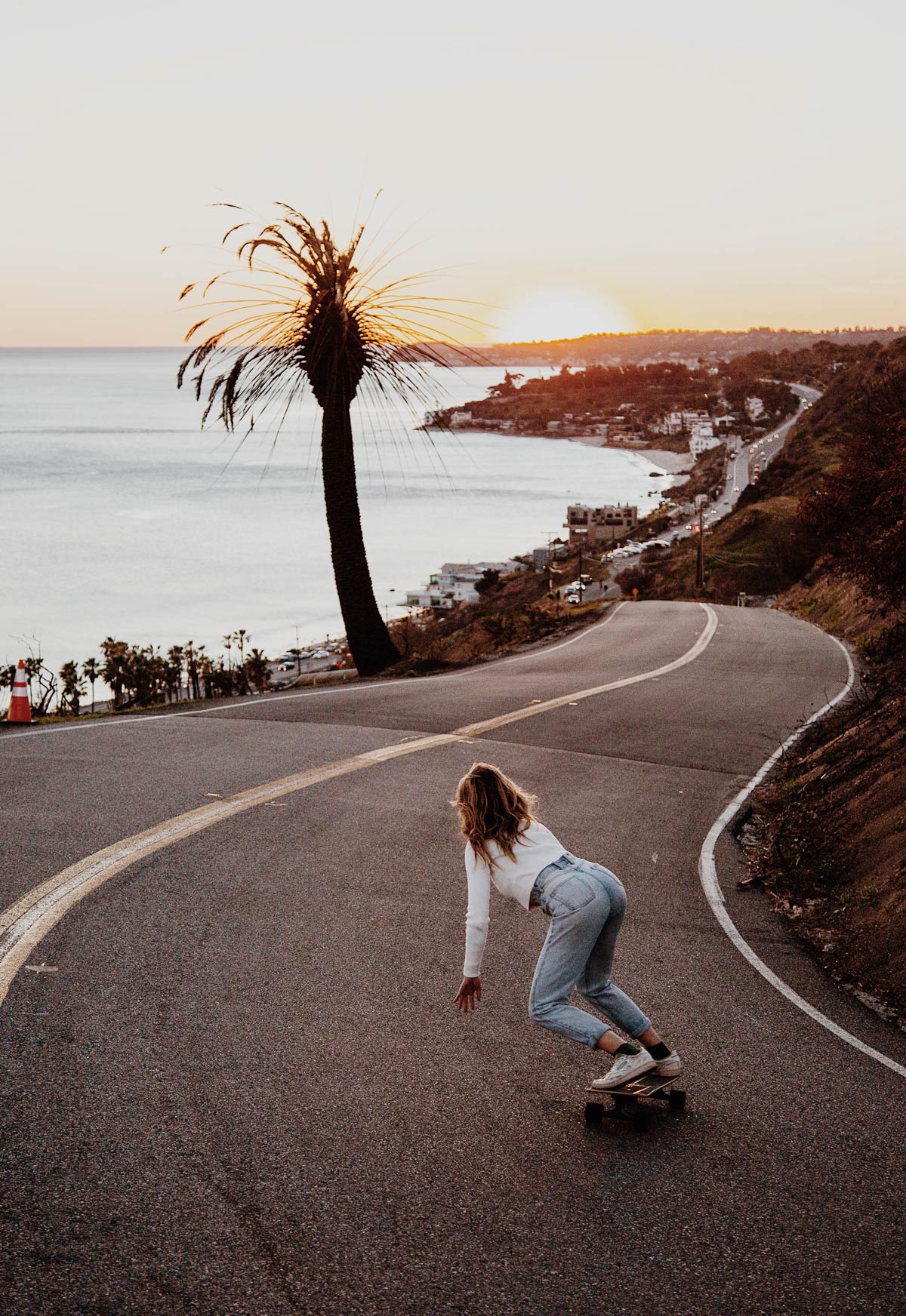
Falling in love with your Carver
As surfers and skateboarders, a sense of style and personal aesthetic is part of everyone’s aspirations. Despite all the technical considerations to take into consideration when choosing your Carver, choosing a style that you really dig and that you will want to carry around and ride all the time is key. The same way that you love the outline, concaves and colours of your surfboard, you can look for the aesthetic characteristics you like on a specific Carver. Having ridden over twenty Carver models I can safely say that there hasn’t been one that isn’t fun or doesn’t work well in some way. In fact, when I bought my first board many years ago, I simply walked into a shop in Southern California—and without doing much research about the trucks, decks or anything else—simply grabbed the one I was drawn to the most. Little did I know that I would immediately fall in love with that board and that it would be the one I would ride for three years. As you narrow down your options and get closer to deciding which one to get, trust your instincts and choose the one you are drawn to the most. I guarantee whatever board you choose will immediately put a smile on your face—and, with time—you will master every nuance of its riding ability while learning to love the board you have.
Choose your carver now
Words by Antonio Lennert. Photographs Carver Skateboards.

Antonio is an ISA-certified surf coach, movement teacher and community builder. He was born and raised in Brazil and graduated from OCAD University with a degree in Graphic Design. Antonio is the founder and CEO of Surf the Greats and also teaches Carver Clinics in Toronto. Find him on Instagram.






